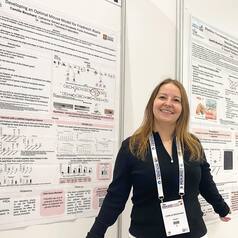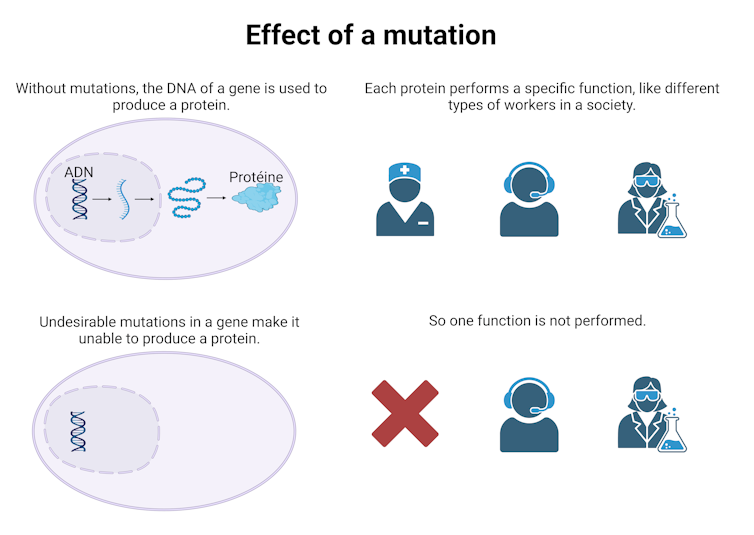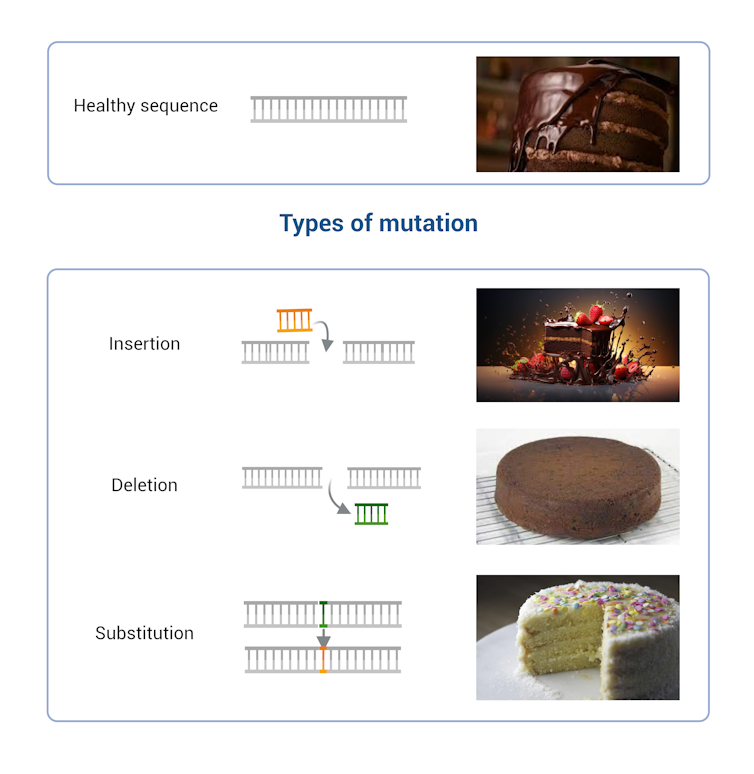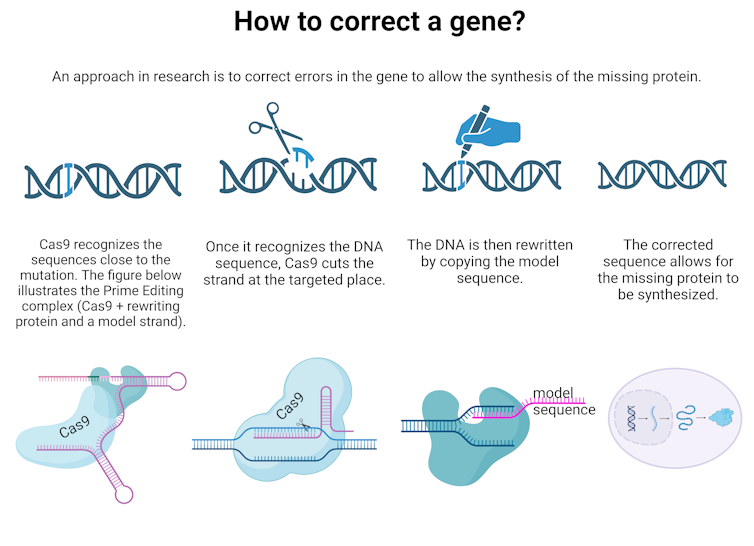I have always been fascinated by genetics, a branch of biology that helps explain everything from the striking resemblance between different members of a family to the fact that strawberry plants are frost-resistant. It’s an impressive field!
I also have a personal connection to genetics. Growing up, I learned that members of my family had a form of muscular dystrophy called dysferlinopathy. I watched as my mother gradually lost the ability to climb stairs and had to use a cane, then a walker, and finally a wheelchair to get around. Her leg muscles were less and less able to repair themselves and became weaker with time.
My parents explained to me that all these changes were due to the error of a single letter among the billions of letters in a long DNA sequence. This error prevents the production of the protein responsible for repairing arm and leg muscles.
Today, I am a doctoral research student in molecular medicine. I study the treatment of hereditary diseases in order to be able to help families like my own. In this article, I will demystify hereditary diseases and show what research is being carried out to treat them.
A piece of cake? Not quite
Let’s start by imagining DNA as a recipe book. Each gene represents a different recipe. The page with the chocolate cake recipe has a nice picture, but there is some information missing. The recipe says to preheat the oven and measure the flour, but the rest of the page is torn. So it is impossible to make the cake. We go ahead and serve our meal made from all the other recipes, but there is no chocolate cake even though this is a particularly important part of the meal.
The same is true for hereditary diseases. In this case, the body can make all the proteins it needs except one. In dysferlinopathy, which affects my family, the missing recipe is the protein that repairs the muscles of the arms and legs. Each hereditary disease has its own damaged page in its recipe book.
Effects of a mutation. (Camille Bouchard), Fourni par l'auteur
To be precise, an error in the DNA is called a mutation. There are different types of mutations. Some are caused by adding letters, like adding an ingredient to the recipe. This addition could lead to a delicious chocolate cake with strawberries, or to a cake that is no longer edible because we added motor oil to it.
Other mutations are caused by the removal (or elimination) of one or more letters (or ingredients), or by substitutions that replace one letter with another. All of these modifications can lead to favourable or non-impactful changes, such as the appearance of the first blue eyes in evolution, or the ability to breathe outside of water. But these modifications can also bring about unfavourable results, such as a hereditary disease or cancer.
There are different types of mutations. (Camille Bouchard), Fourni par l'auteur
Repairing DNA
From a young age, I understood that my mother was sick due to the error of a gene, but that I would not develop the disease because my father did not have the same error. This is called a recessive disease, since there must be an error in the gene of each of the two parents in order for the disease to manifest. Other hereditary diseases are dominant, meaning that a mutation in the DNA passed down from just one parent is enough to impair the production of a protein.
As part of my research, I look at the DNA sequence of each dysferlinopathy patient to see where the error is.
To try to correct it, I use Prime editing, a technique which makes it possible to cut the DNA near the mutation and rewrite the sequence correctly. Prime editing is a version of CRISPR-Cas9, a technique that allows DNA to be cut at a particular location.
Prime editing uses a protein called Cas9, which occurs naturally in bacteria. This protein allows bacteria to destroy the DNA sequences of viruses that could infect them. The mission of the Cas9 protein is to recognize a sequence and cut it.
When we use Cas9 in our human cells, we attach it to another protein, which rewrites the DNA sequence based on a template. In other words, we give the cell an error-free sequence so that it can go ahead and manufacture the protein on its own. It’s a bit like recovering the original page of the recipe book so you can finally serve the chocolate cake.
A step in the right direction
So why aren’t we hearing about Prime editing, when it could be used to treat a variety of diseases? Because the technology is not yet fully developed. At the moment we are able to repair DNA directly in cells in the laboratory, but we lack the means to deliver the two large proteins (Cas9 and the one that rewrites) to the cells to be treated (for example, to the centre of the affected muscles).
Prime editing is a technique being studied to correct mutations in different genes. (Camille Bouchard), Fourni par l'auteur
In other words, we have found the chocolate cake recipe, but it’s written on a page that is too large to fit in an email or put in an envelope. Many laboratories, including mine, are looking for an efficient and safe vehicle that will be able to deliver these proteins.



 Senate Sets December 8 Vote on Trump’s NASA Nominee Jared Isaacman
Senate Sets December 8 Vote on Trump’s NASA Nominee Jared Isaacman  Trump Administration to Launch Autism Initiatives Targeting Acetaminophen Use and New Treatment Options
Trump Administration to Launch Autism Initiatives Targeting Acetaminophen Use and New Treatment Options  NASA Astronauts Wilmore and Williams Recover After Boeing Starliner Delay
NASA Astronauts Wilmore and Williams Recover After Boeing Starliner Delay  FDA Pilot Program Eases Rules for Nicotine Pouch Makers
FDA Pilot Program Eases Rules for Nicotine Pouch Makers  SpaceX’s Starship Completes 11th Test Flight, Paving Way for Moon and Mars Missions
SpaceX’s Starship Completes 11th Test Flight, Paving Way for Moon and Mars Missions  EUR/USD Smashes 1.1660 as ADP Jobs Massacre Crushes the Dollar
EUR/USD Smashes 1.1660 as ADP Jobs Massacre Crushes the Dollar  Trump Signs Executive Order to Boost AI Research in Childhood Cancer
Trump Signs Executive Order to Boost AI Research in Childhood Cancer  Neuren Pharmaceuticals Surges on U.S. Patent Win for Rare Disorder Drug
Neuren Pharmaceuticals Surges on U.S. Patent Win for Rare Disorder Drug  SpaceX Starship Test Flight Reaches New Heights but Ends in Setback
SpaceX Starship Test Flight Reaches New Heights but Ends in Setback  Airline Loyalty Programs Face New Uncertainty as Visa–Mastercard Fee Settlement Evolves
Airline Loyalty Programs Face New Uncertainty as Visa–Mastercard Fee Settlement Evolves 































